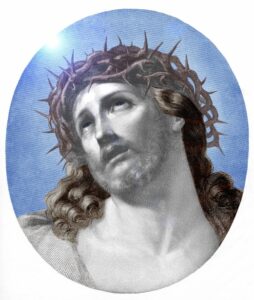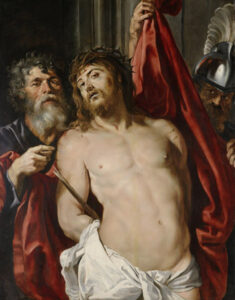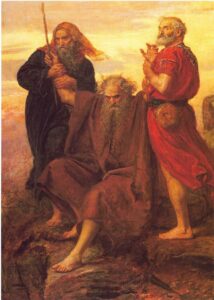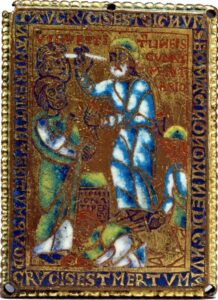 Continuing here Nanine Charbonnel’s Jésus-Christ, Sublime Figure de Papier. This post covers pages 398 to 411. I have questions and some doubts about certain connections that are being made in these pages and note NC’s occasional expressions of tentativeness. But I’ll try to present here the key points expressed and from time to time add what I think is an alternative (or additional) rationale for some of the points made. One question raised is whether some of the connections proposed are the results of reflection on the cross rather than inspirations for introducing the cross into theological imagery in the first place.
Continuing here Nanine Charbonnel’s Jésus-Christ, Sublime Figure de Papier. This post covers pages 398 to 411. I have questions and some doubts about certain connections that are being made in these pages and note NC’s occasional expressions of tentativeness. But I’ll try to present here the key points expressed and from time to time add what I think is an alternative (or additional) rationale for some of the points made. One question raised is whether some of the connections proposed are the results of reflection on the cross rather than inspirations for introducing the cross into theological imagery in the first place.
1. Two Sides of the Passion: Positive Outcome of an Ordeal
The message is that the people of Israel, though dead, will be victorious. Through death comes resurrection. Some specifics:
 Crown of Thorns
Crown of Thorns
NC suggests that this “apparent instrument of torture is in fact the emblem of divine kingship”. The possibility of its relationship with the Burning Bush in the Exodus is raised (think of the bush as the place where the divinity dwells), as also the possible allusion to the thorn bush that became king in Judges 9:7-15. Salomon Reinach states that the idea that the crown of thorns was intended to inflict suffering on Jesus was “very late” (“très postérieure”) — though the reasons for this claim are not given at Le Roi supplicié.
Marc-Alain Ouaknin, NC with some caution notes, points to kabbalistic associations, and others have remarked on the crown being a rabbinical metaphor for the Torah, but surely more significant than any of these suggestions is the eschatological significance, in this case, the link with the Feast of Tabernacles. To quote Jean Daniélou in Les Symboles chrétiens primitifs:
But we confine ourselves here to the use of crowns of foliage at the feast of Tabernacles. And it seems to us, from all the texts that have been brought together, that it is to this usage that the Jewish and Judeo-Christian symbolism of the crown to symbolize eschatological glory. This usage, like its symbolism, seems relatively recent in Judaism. Judaism. It is related to the development of the messianic of messianic expectation and, in literary terms, with apocalypticism. (Daniélou, p. 30)
Original:Et il nous paraît, d’après l’ensemble des textes rapprochés, que c’est à cet usage que se rattache le symbolisme juif et judéo-chrétien de la couronne pour symboliser la gloire eschatologique. Cet usage, comme son symbolisme, paraît relativement récent dans le judaïsme. Il se trouve en relation avec le développement de l’attente messianique et littérairement avec l’apocalyptique.
In my mind, however, a crown of plants suggesting a return to the original Garden of Eden situation does not seem compatible with a crown of thorns.
The magnificent purple cloak
The cloak draped upon Jesus was “lampran” (Luke 23:11) – glorious, magnificent; Mark 15:17 and John 19:2, 5 inform us it was purple. NC raises questions: is this the garment of the High Priest? or the robe of King Saul? Certainly, it is a royal garment, but it is a cloak and not a full dress. “Many midrashim” speak of God putting on a royal mantle as he prepares to act in bloody vengeance on the “last day” — e.g. Isaiah 63:2-4. Again there is reference to late Ashkenazi messianic imagery with the suggestion that certain ideas could be “much older”. All of these points briefly touched by NC may be suggestive but I can’t help thinking they are inconclusive. (One point: I am left wondering about the colour red in some of the references instead of purple.)
Behold the man
 John 19:5 “Behold the man” — with these words Pilate presents Jesus to the crowd. This is the same phrase as the Septuagint (Greek version) uses to present the first king of Israel: ἰδοὺ ὁ ἄνθρωπος — “behold the man” in 1 Samuel 9:17 (Greek text). One may well see here a “subtle” announcement of Jesus as the “king of the Jews”, the words to be placed on the titulus above the cross.
John 19:5 “Behold the man” — with these words Pilate presents Jesus to the crowd. This is the same phrase as the Septuagint (Greek version) uses to present the first king of Israel: ἰδοὺ ὁ ἄνθρωπος — “behold the man” in 1 Samuel 9:17 (Greek text). One may well see here a “subtle” announcement of Jesus as the “king of the Jews”, the words to be placed on the titulus above the cross.
Pilate washes his hands: Possible allusions — Deuteronomy 21:6-7 and Psalm 26:6. Is it a leap too far to think of the practice of Jews washing hands before writing the name of YHWH? (I think that last suggestion is too indirect to be sustained.)
2. The Cross: between language and object
 Again we enter a world of symbolic meaning. Paul spoke of being crucified with Christ as a metaphor for mortifying evil passions. In an earlier post (2013) we were discussing another scholar who believes that Christianity was largely founded on the rewriting of Jewish Scriptures and included a reference to a mid-second century description of the practice of roasting a lamb on a spit resembling a cross. So I won’t repeat NC’s point about the same here.
Again we enter a world of symbolic meaning. Paul spoke of being crucified with Christ as a metaphor for mortifying evil passions. In an earlier post (2013) we were discussing another scholar who believes that Christianity was largely founded on the rewriting of Jewish Scriptures and included a reference to a mid-second century description of the practice of roasting a lamb on a spit resembling a cross. So I won’t repeat NC’s point about the same here.
Since earliest times some exegetes have seen a shadow of the ram that was caught in the bush and substituted for Isaac:
This “wood,” again, Isaac the son of Abraham personally carried for his own sacrifice, when God had enjoined that he should be made a victim to Himself. But, because these had been mysteries which were being kept for perfect fulfilment in the times of Christ, Isaac, on the one hand, with his “wood,” was reserved, the ram being offered which was caught by the horns in the bramble; Christ, on the other hand, in His times, carried His “wood” on His own shoulders, adhering to the horns of the cross . . .
Tertullian: Contra Jews 13, 21
Most often, as a Christian symbol, the cross is elevated, suggesting a kind of exaltation and victory, as we see below.
Cross creates unity
We see in Ephesians that through the cross two peoples are made one:
For he himself is our peace, who has made the two groups one and has destroyed the barrier, the dividing wall of hostility, by setting aside in his flesh the law with its commands and regulations. His purpose was to create in himself one new humanity out of the two, thus making peace, and in one body to reconcile both of them to God through the cross, by which he put to death their hostility. — Ephesians 2:14-16
Do we see here some form of fulfillment of Ezekiel 37:15-20 —
The word of the Lord came to me: “Son of man, take a stick of wood and write on it, ‘Belonging to Judah and the Israelites associated with him.’ Then take another stick of wood, and write on it, ‘Belonging to Joseph (that is, to Ephraim) and all the Israelites associated with him.’ Join them together into one stick so that they will become one in your hand.
“When your people ask you, ‘Won’t you tell us what you mean by this?’ say to them, ‘This is what the Sovereign Lord says: I am going to take the stick of Joseph—which is in Ephraim’s hand—and of the Israelite tribes associated with him, and join it to Judah’s stick. I will make them into a single stick of wood, and they will become one in my hand.’ old before their eyes the sticks you have written on
Cross as sign of victory
We know that Christianity did not embrace a “cult of the cross” until late antiquity and NC warns readers to be cognizant of that fact throughout this discussion. The cross was, however of significance as a sign of power. Hence Justin writing in the mid-second century:
But in no instance, not even in any of those called sons of Jupiter, did they imitate the being crucified; for it was not understood by them, all the things said of it having been put symbolically. And this, as the prophet foretold, is the greatest symbol of His power and role . . .
Later in the same work Justin associates the cross with the saving bronze serpent set up in the Tabernacle by Moses and with the Greek letter chi that was used by Plato as a central image for the universe:
And the physiological discussion concerning the Son of God in the Timaeus of Plato, where he says, “He placed him crosswise in the universe,” he borrowed in like manner from Moses; for in the writings of Moses it is related how at that time, when the Israelites went out of Egypt and were in the wilderness, they fell in with poisonous beasts, both vipers and asps, and every kind of serpent, which slew the people; and that Moses, by the inspiration and influence of God, took brass, and made it into the figure of a cross, and set it in the holy tabernacle, and said to the people, “If ye look to this figure, and believe, ye shall be saved thereby.” And when this was done, it is recorded that the serpents died, and it is handed down that the people thus escaped death.
Mention is also made of “an ancient tradition” in which the anointing of the high priest was performed by pouring oil between his eyes and forming the sign of the Greek letter — and that this letter was seen as significant as the first letter of Christ.
 New Moses and raised arms
New Moses and raised arms
There is a suggestion of the cross in Isaiah 9:6 ”a child is born to us, a young man is given to us, the sign of power [le signe de la puissance] is on his shoulders”. (All English translations that I see choose the word “government” or “rule” in place of “power”.)
Justin again, in his Dialogue with Trypho, ch.90
“Bring us on, then,” said [Trypho], “by the Scriptures, that we may also be persuaded by you; for we know that He should suffer and be led as a sheep. But prove to us whether He must be crucified and die so disgracefully and so dishonourably by the death cursed in the law. For we cannot bring ourselves even to think of this.”
“You know,” said I, “that what the prophets said and did they veiled by parables and types, as you admitted to us; so that it was not easy for all to understand the most [of what they said], since they concealed the truth by these means, that those who are eager to find out and learn it might do so with much labour.”
He answered, “We admitted this.”
“Listen, therefore,” say I, “to what follows; for Moses first exhibited this seeming curse of Christ’s by the signs which he made.”
“Of what [signs] do you speak?” said he.
“When the people,” replied I, “waged war with Amalek, and the son of Nave (Nun) by name Jesus (Joshua), led the fight, Moses himself prayed to God, stretching out both hands, and Hur with Aaron supported them during the whole day, so that they might not hang down when he got wearied. For if he gave up any part of this sign, which was an imitation of the cross, the people were beaten, as is recorded in the writings of Moses; but if he remained in this form, Amalek was proportionally defeated, and he who prevailed prevailed by the cross. For it was not because Moses so prayed that the people were stronger, but because, while one who bore the name of Jesus (Joshua) was in the forefront of the battle, he himself made the sign of the cross. For who of you knows not that the prayer of one who accompanies it with lamentation and tears, with the body prostrate, or with bended knees, propitiates God most of all? But in such a manner neither he nor any other one, while sitting on a stone, prayed. Nor even the stone symbolized Christ, as I have shown.
Everything is there (in spite of the chronological inversion of the imitations): the cross is the form of the ceaseless prayer and the leader of the victory is the Name of Jesus.
Slightly more interesting (in my view) is an even earlier document expressing the same relationship to the cross, though this text is not mentioned by NC: Barnabas 12:2
In like manner He points to the cross of Christ in another prophet, who saith, “And when shall these things be accomplished? And the Lord saith, When a tree shall be bent down, and again arise, and when blood shall flow out of wood.” Here again you have an intimation concerning the cross, and Him who should be crucified. Yet again He speaks of this in Moses, when Israel was attacked by strangers. And that He might remind them, when assailed, that it was on account of their sins they were delivered to death, the Spirit speaks to the heart of Moses, that he should make a figure of the cross, and of Him about to suffer thereon; for unless they put their trust in Him, they shall be overcome for ever. Moses therefore placed one weapon above another in the midst of the hill, and standing upon it, so as to be higher than all the people, he stretched forth his hands, and thus again Israel acquired the mastery. But when again he let down his hands, they were again destroyed..
Cross, agent of Inversion
John 3:14-15 —
As Moses lifted up the serpent on a pole in the wilderness, so the Son of Man must be lifted up, that everyone who believes in him may have eternal life.
“Lifted up”: the expression inverts the hanging from a tree into an exaltation.
Early Church Fathers frequently interpreted the cross as a new “tree of life” (in place of the one that was lost in the Garden of Eden) and drew links with Psalms, Proverbs and Jeremiah. Enemies who crucified Jesus were accordingly viewed as attacking the tree of life. Even Jacob’s dream of a “ladder” by which angels descended and ascended was interpreted as a cross.
The cross then, as a sign of victory, becomes the curse that “curses the curse” of what had slain the Jews, the letter of the law.
For all who rely on the works of the law are under a curse, as it is written: “Cursed is everyone who does not continue to do everything written in the Book of the Law.” Clearly no one who relies on the law is justified before God, because “the righteous will live by faith.” The law is not based on faith; on the contrary, it says, “The person who does these things will live by them.”Christ redeemed us from the curse of the law by becoming a curse for us, for it is written: “Cursed is everyone who is hung on a pole.” — Galatians 3:10-13
There is also the inversion of substitution. As Haman was hanged on the gallows he had meant for his enemy (Esther 7:9-10), so Jesus, the innocent, takes the place of the guilty, both Jews and Romans.
The death of Jesus is at the centre of numerous substitutions in the narratives. In various accounts it is said that others died in place of Jesus, or Jesus had a twin who was confused with him, or that he was not real flesh and blood but only spirit that could not be nailed to the cross, not forgetting the Barabbas exchange as well. Jesus in these stories represents the community, the people, for whom he is dying. A real killing had occurred in the events of 70 with the destruction of Jerusalem. What are we to make of the personification of those people being crucified?
Dead, therefore resurrected
Returning to Bernard Dubourg,
If my reader harbors the slightest doubt as to my demonstration and its total primitive Christian flavor, let him learn Greek and Hebrew, let him retrovert the New Testament (from Greek to its native Hebrew) and let him in turn attend, in hundreds of verses, the multicolored midrash that I have just exhumed. He will see that the show is worth the trip. He will even be able to consult, here and there, various ancient apocrypha. And he will see that the Lord is resurrected; he will see that the messiah is a son and that the son is a messiah; and he will see above all that the Lord, Christ-Messiah and the Son are narrative characters (taken from the Bible) forming, lexically, a tight, logical, coherent network, a network having as its focal point, precisely, the resurrection of YHWH. — Bernard Dubourg, L’invention de Jésus, t. II La fabrication du Nouveau Testament, Gallimard, 1989, p. 112
NC, page 407:
One can even refer to the work of a Dominican exegete, who studies closely all the scriptural accounts of a resurrected Messiah [see Philippe Lefebvre, O.P., Livres de Samuel et récits de résurrection, Paris : Cerf, 2004], especially in the books of Samuel. Others can show that the Resurrection, a Pharisaic belief, is at the time of the writing of the New Testament, correlative to the Incarnation of the Word of YHWH [see Didier Long, L’invention du christianisme. Et Jésus devint Dieu, pp. 165-167].
Once more on the collective aspect of the death and resurrection, when Paul says that “he was raised on the third day according to the Scriptures” he is surely thinking of Hosea 6:2, “Come, let us return to the Lord…. on the third day he will have raised us up and we will live in his presence.” We have already seen the collective symbolism in the daughter of Jairus and Lazarus who were raised from the dead.
And we discover that “to be resurrected” meant at that time “to have a posterity“3.
3 The Sadducees rely on Deut 25:6, which they translate as “he shall raise his brother’s seed”; “For the Sadducees, therefore, the survival of a man, or his ‘resurrection’, is his seed”, Etienne Nodet, O.P., Baptême et résurrection. Le témoignage de Josephe, p. 199.
3. Taw, end of the story, divine signature

The last letter of the Hebrew alphabet, Tau or Taw, ת, corresponds to the Greek or Latin T in the shape of a cross and was written in the past either X, or +, or T.
The Sign by which YHWH saves: Ezekiel 9
For NC, this is the sign that YHWH commands Ezekiel to mark on the foreheads of those destined to be saved:
And the Lord said unto him, Go through the midst of the city, through the midst of Jerusalem, and set a mark [תָּ֜ו tāw] upon the foreheads of the men that sigh and that cry for all the abominations that be done in the midst thereof.— Ezekiel 9:4
NC refers to a reference to a study that I am unable to trace. Pierre Bonnard mentions a hypothesis by Dinkler:
It is possible that the expression “to carry his cross” took on another form on the lips of Jesus and did not allude to his own death but to the sign (תו) of repentant Jews (Ezek. 9:4ff., the Psalms of Solomon and the Damascus Document); this is the interesting hypothesis of Dinkler (Hommage Bultmann, 1954, pp. 110-120); the Matthean formula would then be a Christian transcription belonging to a time when the cross became the Christian sign par excellence. –Bonnard, L’Évangile selon saint Matthieu, p. 250
The Zohar is said to see in the mark a curse, death. For NC, this contradictory association may suggest that the mark had an ambiguous aspect as the cross came to have: a sign of life for some and death for others.
Qumran’s Damascus Document informs us that this mark of Ezekiel was believed to have relevance to the final generation at the end time of God’s judgment.
NC does bring the Letter of Barnabas into her discussion at this point, however. Keep in mind that this letter is probably very early, no later than the early decades of the second century:
Barnabas 9:6-7
Learn therefore, children of love, concerning all things abundantly, that Abraham, who first appointed circumcision, looked forward in the spirit unto Jesus, when he circumcised having received the ordinances of three letters.
For the scripture saith; And Abraham circumcised of his household eighteen males and three hundred. What then was the knowledge given unto him? Understand ye that He saith the eighteen first, and then after an interval three hundred. In the eighteen ‘I’ stands for ten, ‘H’ for eight. Here thou hast JESUS (IHSOYS). And because the cross in the ‘T’ was to have grace, He saith also three hundred (=Tau). So He revealeth Jesus in the two letters, and in the remaining one the cross.
NC sees here evidence that midrashic interpretations continued beyond the Hebrew texts and were also applied to the Greek. But there does appear to be a problem in giving Tau the value of 300 since it is more widely accepted as representing 400; further, the Hebrew letter as we know it does not look like a cross — although the cross was its much earlier design. (I am used to skipping over these sorts of discussions and interpretations we find above in Barnabas and relegating it to speculation.)
Taw, Sign of the Name of God
As the last letter of the alphabet the taw is, according to early Jewish understanding or at least among Jewish mystics of a later period (were their views originally found among Second Temple scribes?), said to bear the strength of all the previous letters combined. The one who wears it thus possesses the capacity to start again at the beginning of the alphabet, “to renew his being.” The taw, in this context among mystics, was interpreted as the abbreviation for the name of YHWH and hence took on the meaning of that name. Quoting Jean Daniélou, which I translate,
…. the Hebrew taw, which is the last letter of the alphabet, designates God, as does the Greek omega. …. It seems, therefore, that the first Christians were marked on their foreheads with a taw which designates the Name of Yahweh. …. For the early Christian community, the Name which, in the Old Testament, designates the manifestation of God in the world, in competition with the Word, was a designation of Christ as the Word of God incarnate. …..
It can therefore be considered certain that the sign of the cross with which the first Christians were marked designated for them the Name of the Lord, that is, the Word, and signified that they were consecrated to him. In Greek, this symbolism was incomprehensible. — Les Symboles chrétiens primitifs, pp. 147-149.
History’s final signature
In Job 31:35 Job declares that he writes his signature, his taw, at the conclusion of his defence. From the above one can see in the sign of taw the divine signature at the end of history, the sign of the end of God’s people with the destruction of their Temple and the renewal of a new people of God to eternal life.
I have not been able to follow up many of NC’s citations in this section and much of it does strike me as a proposal concerning concepts that came prior to the gospels and other New Testament writings, and very much a statement of possibilities, but lacking in demonstrable proof.
There is one more chapter to cover before the conclusion of NC’s book.
Charbonnel, Nanine. Jésus-Christ, Sublime Figure de Papier. Paris: Berg International, 2017.
If you enjoyed this post, please consider donating to Vridar. Thanks!


I am still curious as to how it is that Jesus’s crucifixion changes anything? So, he was killed and resurrected, so what? How does that change the rest of the theological world . . . unless, of course you believe in blood magic, which apparently a lot of Christians still do. I read claims of people stating that the “blood of Christ” will protect them form COVID-19, for example.
Without some sort of mechanism by which these changes occur, then how is it that Yahweh’s curse is lifted? Why not just have Jesus walk around claiming that Yahweh’s curse is lifted if ? Then is Jesus is killed for his temerity and then resurrected, he would be identified as someone who is favored by Yahweh and should be taken seriously. As it was (at least claimed to be) what was Jesus’s message? the one hammered home by his resurrection, which seemed to cap his mission without a banner of “Mission Accomplished” but presumable could have.
In the dynastic politics of a client state on the eastern periphery of an empire what if the historical figure behind Jesus was some sort of pretender turning up out of the blue claiming to be ‘King of the Jews’? Something similar happened three times in a row in early 1600’s Russia.
“False Dmitry, also called Pseudo-demetrius, Russian Lzhedmitry, or Dmitry Samozvanets, any of three different pretenders to the Muscovite throne who, during the Time of Troubles (1598–1613), claimed to be Dmitry Ivanovich, the son of Tsar Ivan IV the Terrible (reigned 1533–84) who had died mysteriously in 1591 while still a child.”
Clicking preview anyone can skim through a pdf of a book claiming something similar to this that an ex-Catholic trial lawyer wrote a decade back: https://www.pdfdrive.com/herodian-messiah-case-for-jesus-as-grandson-of-herod-e162582176.html Tells you too who Paul (Jesus’s distant Herodian cousin) and Josephus (son of the penultimate high priest) really could have been. To paraphrase Clausewitz: Religion is only a continuation of politics by other means.
Or in other words, a continuation of secular concerns.
Personally I like to sometimes think of the T or X, as a simple proto-geometric precursor to the notion of intersection; terminus; the points of a compass; and Cartesian coordinates.
Not to deify it, of course.
Edit: Josephus (son of the final high priest; the one killed by zealots)
They showed Jesus a gold coin and said: Caesars men wanted tribute from us. He replied: Render unto Caesar what belongs to Caesar, and render unto God, what belongs to God, and give me what is mine. “and give me what is mine” is a royal pretender with a rabble of supporters staking a claim to a throne.
If there is a historical character at the core then their story is all back stabbing dynastic politics and palace coups.
I agree that many very ordinary, low impulses and men, were behind much of Christianity, in essence. Though the peripheral things, symbols – like crosses and so forth – which came well before say 35 AD, may be more interesting and complicated.
Very ordinary low impulses of men stemming from power politics were behind another great religion in the years after 622: https://www.tingismagazine.com/articles/islam-arabs-and-the-hijra/
Then decades later someone turned the Christian epithet muhammad [the chosen/praised one; or the one to be praised] into the personal name of a whole new prophet [son of an Abdullah derived from the epithet Abd Allah literally ‘son of god’] with an extensive though cobbled together fictional backstory that few are brave enough to risk the ire of Saudi Barbaria’s minions by delving deep into: http://inarah.net/publications Most of them are deep into retirement are closing in on it fast so not especially afraid of getting “canceled” now.
Especially if you write it as +, it becomes relevant to such things.
Those Branch Davidian idiots in Waco strike again. ” “And there shall come forth a rod out of the stem of Jesse, and a branch (neṣer) shall grow out of his roots”—a verse that in Jewish circles has a long tradition of Messianic interpretation. Neṣer here means “branch,” from which root the Davidic Messiah shall come forth (hence the infamous Branch Davidians of recent memory).” Two lines from the Semiticist Robert Kerr in an article linked to in a comment that Topliss fellow posted yesterday. Getting to the bottom of what exactly is and isn’t a Nazarene in more than one century would clear up a lot of enigmas in more than one religion. There was a priest from some Catholic order in France named Edouard Gallez who was way down in this Nazarene rabbit hole a few years ago. Probably still lost down in there somewhere. Seems to me he was a linguistic student of a Lebanese Melkite prelate who’d narrowly missed being murdered at some mission the Vatican had in Algeria in the nineties.